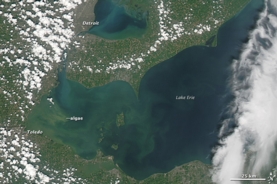Texas Drinking Water Systems Draw Federal Concerns
by Neena Satija
More than 310 public drinking water systems in Texas — nearly 4.5 percent of the state’s regulated public water systems — have quality issues that haven’t been adequately addressed, federal officials told the Texas Commission on Environmental Quality this year. That is the highest percentage in the nation, according to the Environmental Protection Agency.
Most are small public water systems, like mobile home parks, serving a few hundred people or fewer. But a few are larger and serve thousands.
TCEQ officials say the federal estimate is outdated and high; by their account, about 4 percent of systems have issues that need more attention. The agency said it has dramatically stepped up its enforcement in the past year, training more staff and pursuing more than 100 public water systems in recent months for clean water violations.
Still, the EPA’s concerns and additional data suggest that keeping up with the 7,000 public water systems subject to state regulation in Texas has been a huge challenge. The TCEQ’s enforcement division now has 107 full-time employees, compared with 117 in 2007, though its annual expenses have stayed relatively constant at about $5.5 million.
“There could be more resources brought to bear,” said Robert Doggett, general counsel for Texas RioGrande Legal Aid, which serves border regions where many public water systems have committed clean water violations.
Some districts have the money to fix their water issues, Doggett said. “Others are poor, and they don’t have the money and expertise, and they need help. Either way, it’s a problem, and why hasn’t the state agency done much about it?”
In an email, TCEQ spokesman Terry Clawson said, “Texas’ drinking water systems face a wide array of challenges in meeting the public health protection standards aimed at ensuring safe drinking water.”
In its March letter to the TCEQ, the EPA wrote that an alarmingly large number of systems in Texas had problems that took the TCEQ too long to seriously address. Dozens have not been compliant with clean water law for close to five years, according to the EPA.
A separate EPA review done in 2012 found that nearly a quarter of public water systems in Texas had committed significant violations of water law — either because of unhealthy levels of contaminants, or because they failed to test water properly and frequently enough. That’s a higher percentage of violations than in other large states, such as California, where 8 percent of water systems had committed significant violations.
Many of the systems with the most severe problems are in remote areas and serve only a few dozen people. Their water resources have naturally occurring contaminants like arsenic that are enormously expensive to remove. Operators also constantly change or are hard to reach, making regulation by the state particularly difficult.
That appears to be the case, for example, with “Cyndie Park II Water Supply Corp.,” which serves just over a dozen households in a Nueces County colonia. The water comes from portions of the Gulf Coast Aquifer that have high levels of arsenic. Long-term human exposure to arsenic has been linked to liver, prostate and many other types of cancer.
For more than 10 years, the TCEQ has regularly cited Cyndie Park II WSC for providing water with dangerously high levels of arsenic as well as coliform — microorganisms that could indicate the presence of disease-causing bacteria such as E. coli. It has also sent dozens of notices in recent years alleging that the system is not routinely testing its water or reporting test results to the state. But there was no apparent improvement; last fall, arsenic levels were at 15 micrograms per liter, according to EPA data; the federal limit is 10.
In 2011, residents were asked on three separate occasions to boil their water because of problems with the system, according to state data. The agency sued Cyndie Park II WSC in 2012 and demanded $150,000 in fines, but never received a response.
“None of us here drink the water,” said Robert Burleson Jr., a retired resident who lives with his wife on a fixed income. “We don’t cook with it. All we do is shower and wash dishes.”
Burleson said he spends about $10 per week on water jugs in Corpus Christi, 17 miles away. That’s in addition to the water bill he pays Cyndie Park II WSC. “That’s about all anybody can afford out here,” he said. The median annual income for area households is less than $30,000.
Burleson used to serve as president of the water cooperative’s board, but quit — with the rest of the board members — a few years ago out of frustration. “Nobody had any money” to fix the arsenic problem, he said. “I had engineers do work on it and put in for grants and stuff, but we never got anything.”
Nueces County received $150,000 from the TCEQ to install an arsenic removal system that will come online in the next few months. But County Commissioner Joe Gonzalez said many other problems remain, including water lines that are cracking and ready to break. Water service was out for nearly a month last year because of such issues, he said. Some of the $150,000 remains and will be used to fix the water lines, but more is needed.
Gonzalez said that his long-term goal is to provide residents with a new supply of water. Along with arsenic, other contaminants and high salt levels consistently plague the groundwater that supplies the colonia and other nearby residents today.
Planning, design and construction costs to connect to a larger public water supply system that relies on cleaner surface water would be around $1 million, and the county plans to apply for grants from the state. But it will likely be years before any construction begins.
“We try to do what we can with the money we have, but sometimes those grants are hard to come by,” Gonzalez said.
Source: The Texas Tribune.
Pure Water Gazette Fair Use Statement










![pwanniemedium[1]](http://www.purewatergazette.net/blog/wp-content/uploads/2012/05/pwanniemedium1-246x300.jpg)


